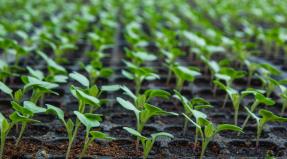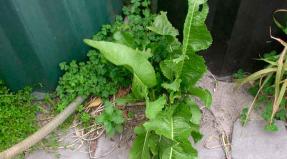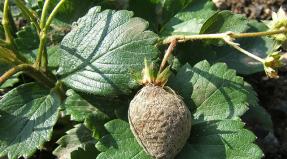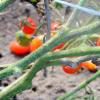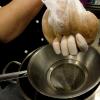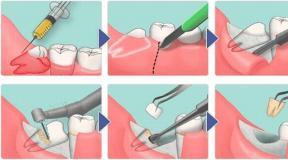Raspberry bushes dry up what to do. Raspberry dry leaves: causes and recipes for recovery. How to protect raspberries from pests and diseases
The main cause of the death syndrome (fragility) of raspberry stems is damage by shoot gall midge and damage by phytopathogenic fungi that cause diseases (mainly purple spot).
The death of stems is manifested in the fact that after overwintering, all or individual buds, part of the stems or whole stems grow back weakly, their growth is greatly delayed or they wither before fruiting. Severely damaged and diseased stems dry up and die off. The process is especially intensified in dry years. Often, the syndrome leads to the loss of up to 60% of the stems and about 70-80% of the kidneys. Young plantings cannot normally begin to bear fruit.
Physiological cracking of young stems in the process of their growth, which opens the gate for the larvae of the raspberry shoot gall midge and a complex of phytopathogenic fungi, favors the death syndrome. Cracking of the stems is exacerbated by a lack of moisture in the soil or by irregular plant growth accelerated by fertilizers. In such cases, it is sometimes useful to mulch the soil on the plantations. It protects plant roots and postpones cracking to a later date. In this case, cracks on the stems become accessible only to the last generations of the shoot gall midge, when the most critical period for damage and defeat of raspberries has passed, and the plants themselves acquire physiological resistance to fungi. Mulching, of course, can significantly improve the growth of stems, but at the same time they ripen poorly in conditions of waterlogging, lose frost resistance, and damage to plants by gray rot is activated, which is one of the factors of death.
Various types of mechanical damage (damage during care, frost cracks, etc.) can also serve as gates for infection. At the same time, growth cracks and mechanical damage in the absence of gall midges and fungi overgrow. For this reason, the key role in the development of stem death is assigned to the raspberry shoot gall midge. Its larvae destroy the peridermis - the main barrier for the penetration of phytopathogenic fungi into the inner tissues of the stem. With a strong infection with fungi, ulcers from the feeding of numerous larvae can ring the stem, disrupting the sap flow and causing its death. In addition, as a result of damage to the cambium, growth stops at the sites of damage, depressions are formed, which can cause the stem to break off.
Gall midge lays eggs in fresh, non-dried wounds of only young, but not last year's stems. Females of the shoot gall midge are attracted by the smell of raspberry juice. It is also fundamentally important to cover the eggs with the edges of the exfoliated epidermis or primary cortex. Depending on the temperature, after 2-8 days, larvae hatch from the eggs, which feed on the tissues of the bark, cambium. The larvae secrete outside enzymes that dissolve the contents of the cells, which are then absorbed by insects. The damaged tissue turns brown and is pressed in. Outside, the sites of damage appear in the form of spots from purple to brown. The sites of damage are inhabited by fungi, which are fixed in cells damaged by gall midges, and then penetrate into the underlying vascular tissues, and sometimes into the core of the stem. They finally weaken the shoots, blocking sap flow.
Most of the eggs and larvae of gall midge are localized in cracks closer to the base of the stem at a height of up to 20 cm, less often 30-50 cm of the soil level. Depending on the weather conditions, the larvae feed here for about 10-25 days (longer in cold periods). Fattened adult larvae fall to the soil and burrow into it 1-2, less often 3-4 cm, where they pupate. After 2-3 weeks in summer, adult insects of the second and subsequent generations fly out of the cocoons. Some of the larvae of the second and subsequent generations enter diapause and emerge only next spring.
In central Russia, the shoot gall midge gives two generations a year (rarely partially 3). In the southern regions up to 4-5. As a rule, one generation of gall midges is superimposed on another; there is no clear border between them. Adult mosquitoes themselves are capable of scattering only short distances, and mainly fly in the crown of the bush from under which they appeared. However, the wind can carry them over considerable distances.
The emergence of the wintering generation of insects is observed approximately during the period of mass flowering of currants and depends on weather conditions. If the spring is cold and prolonged, then the first mosquitoes fly out in the second half, towards the end of May. In years when spring is early and warm, insects can fly out at the end of April - first half of May.
The active growth of raspberry stems also depends on weather conditions. High temperatures contribute to the fact that by the end of May, young stems reach a height of 40 cm and massively crack. Years of mosquitoes also reach their peak around this period, at the same time there is an intense infection of the stems with purple spot. It should be noted that in cool years, the growth of stems and their cracking slows down, and therefore the intensity of stem damage by fungi decreases by 1.5-2 times.
Years of the second generation of mosquitoes begins from about mid - late July and continues until the end of August. The intensity of colonization of raspberry stem wounds from the feeding of the second generation larvae with purple spot is approximately two times lower than that of wounds from the first generation larvae.
Damage to raspberry stems by larvae of raspberry shoot gall midge contributes to their infection with phytopathogenic fungi. With the syndrome of withering away (brittleness), the dynamics of the manifestation of purple spotting on raspberry stems in central Russia is characterized by two peaks in the intensity of the lesion - from late June to early July and from late July to early August, which coincides with the peaks of the number in the stems of the shoot gall midge larvae.
To protect raspberries from harmful organisms that cause stem death (fragility) syndrome, it is necessary to provide spatial isolation of new plants from old infected plantings. Immediately before planting, it is necessary to rinse the roots of raspberry seedlings from the soil on a firm ground or on a net under a good pressure. Next to the site it is necessary to dig a drain hole into which water will drain together with the soil and cocoons of the shoot gall midge. After washing the roots, the pit is covered with soil 10-12 cm to prevent adult gall midges from flying out from there. In autumn (immediately after planting) or early spring, the stems of the seedlings should be cut at soil level.
It is also necessary to carry out phytosanitary cleaning of plantings in a timely manner - to cut and remove damaged and affected shoots. If necessary, spraying is carried out on queen cells and new plants that do not enter fruiting in the current year. Plants are treated from the time of regrowth of young shoots to a height of 15-20 cm until the end of their growth. 1-2 treatments are carried out against each generation of the shoot gall midge (depending on the number of the pest) immediately before the mass summer and during the mass summer. Against gall midge and fungi, you can use treatment with mixtures of one of the indicated insecticides - "Actellik" (0.2%) "Fufanon" (0.3%) and fungicide "Topaz- (0.1%). The lower part of the bushes is especially carefully treated.
On fruiting raspberry plantations, treatments are carried out before flowering and after harvesting one of the above mixtures (insecticide and fungicide). If necessary, after flowering, you can carry out 2-3 treatments with the biological product Fitoverm (0.3%) with an interval of 7-8 days.
What's the trouble with raspberries? Which year dries up and dies. But before that, dark stripes appear on the shoots of the bush, which seem to ring the branch.
Of course, without seeing the patient, it is impossible to make a specific diagnosis. But offhand, an experienced agronomist suggested that we are talking about a raspberry disease such as didimella or raspberry purple spot. Its symptoms are characteristic purple spots around the base of the leaf.
Growing up, the spots merge into larger ones, covering a significant part of the shoot. From the outside in spring, the raspberry thickets consist of strong, lush green plants, from which one would expect a high yield. However, spring passes, summer begins, and one by one the stems dry up, and the rows are thinned out - only individual stems remain.
By autumn, the shoots in the affected areas become gray and crack or form weak fruit twigs the next year. To get rid of the disease, it is necessary to plant varieties that are more resistant to didimella, exclude thickening of the plantation, and try to prevent mechanical damage to the raspberry shoots. In the spring, before bud break, spray with a 3% solution of Bordeaux mixture, in summer before flowering and after harvesting - with a 1% solution.
You can eat raspberries twice a year. Ripening begins in early summer, the second stage of fruiting - in September, when you can treat yourself to raspberries until the first frost. The raspberry bush is an unpretentious plant, but it is also susceptible to various diseases... One of the most common is drying of leaves, berries and shoots. In this article we will try to figure out why the berries, leaves dry and what to do in such cases, what methods of treatment exist.
Causes of drying of branches and berries
The drying process is called withering syndrome... Most young plants are susceptible to it, because when the shrub grows, young shoots crack. This contributes to the rapid penetration into the stem of the larvae of insects and phytopathogenic fungi, the main culprits of drying.
- Disease caused by the reproduction of phytopathogenic fungi, manifests itself in the death of stems in early spring. After winter, infected branches slowly grow back and dry out. If the plant does not have enough moisture, then the process is faster. If you do not take action, you can lose more than half of the stems and ovaries of raspberries.
The stems will crack more severely if they are not properly watered. Excessive fertilization of the soil with growth accelerators will also affect the integrity of the branches, because they do not have time to zap.
- The culprit of the infection of raspberry bushes is the shoot gall midge... Getting through natural cracks or mechanical damage inside the stem, it lays the larvae, which feed on the bark of the plant and destroy its protective layer - the periderm. This is the main barrier that prevents phytopathogenic fungi from entering the plant.
The shoots become a feeding trough for the larvae. In the place of their greater accumulation, ulcers appear, which impede the spread of nutrients throughout the plant. This leads to the death of the upper part of the stem. The disease manifests itself as purple or dark brown spots on the shoots.
Why do berries dry up?
Various viral diseases spread by cicadas and aphids contribute to the drying of raspberries. These sucking insects spread the infection from diseased plants. Diseases are different, but the result is the same for all - drying of the berries.
- With viral chlorosis, berries develop poorly, do not have time to collect juice and color, and eventually dry out.
- With yellow mosaic if the berry does not dry out completely, then it develops one-sided and has a dryish, insipid taste.

- Curl differs in underdevelopment of berries and their drying. Bushes infected with this virus die within a few years.
First of all, diseases affect the harvest. The one-sided development of berries, their crumbling and drying should be a signal for the beginning of emergency actions.
Why do the leaves dry and curl during fruiting?
Viral and bacterial diseases of raspberries, spread by flying insects, provoke drying of the leaves, even during fruiting. Diseases that affect the berries primarily affect the condition of the leaves and their development. The same viruses have a negative effect on the plant and yield:
- Viral chlorosis... Infected leaves begin to turn yellow, dry and curl in the midst of growth and flowering along with the berries, the shoots become small compared to healthy ones.
- Yellow mosaic... This disease is characterized by yellowing leaves with curled dry edges. It is an insect-borne virus that manifests itself in late spring and mid-August.
- Curl... You can distinguish healthy shoots from sick ones by several signs:
- deceleration growth;
- thickening in diameter;
- discoloration of leaves until brown;
- reduction in leaf size and drying them out.

What is chlorosis and how to treat it
A disease that the raspberry bush often infects is chlorosis. His by the nature of origin, they are divided into:
What does a bush infected with this virus look like:
- yellowing first in the center and then entirely leaves;
- shoots are thinning and stretch out
- berries either do not form at all, or half ripens, and the other half dries.

You need to start fighting chlorosis immediately after planting the plant. For this there is a whole a range of products for spraying the plant and protecting it from sucking insects... If you want to harvest this year, then you should process it in 2 stages:
- In early spring, before bud break, use 3% Nitrafen solution or 0.2% Nicotine sulfate solution.
- Before flowering emulsion of 30% Methylmercaptophos.
After spraying, at least 45 days should pass before the raspberries begin to ripen.
If chlorosis was provoked by unfavorable weather conditions, watering with cold water or a lack of organic compounds, you need to try correct the quality of plant care:
- normalize watering with warm water, it is better if it is river or lake, warmed up in the sun;
- make the soil more fertile due to the introduction of mineral fertilizers;

- soften the soil forest floor or peat.
Remember that it is easier to protect against illness than to cure later.
How to protect raspberries from pests and diseases
Mulching is one of the ways to protect... By protecting the roots of the plant, such a surface layer will allow the plant to grow stronger and postpone to a later date the process of cracking the stems when they become resistant to disease. The layer of mulch must be removed when the first buds appear. The soil under it is always saturated with moisture, this can cause rotting, kidney death and, as a result, drying out.
Mulching is one of the most important conditions for preparing a plant for winter. It prevents roots and shoots from freezing, prevents moisture evaporation and protects against constant winds in some regions.
If you cut off damaged stems in time, you can save part of the shrub. You need to cut off all areas covered with dark spots and small growths... It will be better to remove the entire "diseased" shoot completely.

To give the bush to grow stronger and grow, spraying will help, which must be carried out during a period of rapid growth, early and mid-summer. The lower part of the plant is processed, from the ground level 25 - 30 cm up. The mixtures "Aktellik" - 0.2%, "Fufanon" - 0.3% and "Topaz" - 0.1% are suitable for this. Fruiting raspberries should be sprayed with the same preparations before flowering and after harvesting. To preserve the integrity of the berries, after flowering, you need to carry out 3 treatments with a biological product "Fitoverm" - 0.3% with an interval of 1 week.

Correct planting of young plants
How new bushes are planted will depend on them resistance to shoot gall midge larvae and viral diseases.
- Young plants should be planted away from old bushes that can be infested with larvae and fungi.

- It is necessary to rinse the roots under the pressure of water and wash out all the soil from them... It is recommended to dig a small hole nearby, where water and soil residues will drain. The roots may contain unhatched eggs of the shoot gall midge, which must be neutralized, i.e. bury.
The roots should be placed on a hard surface or placed in a metal mesh to avoid damage.
- After landing completely trim the stalks of the raspberries even if planted in spring.
If possible, cover the raspberry patch with non-woven material to prevent infection with viral infections carried by flying insects.
Spray once every 2 weeks with Bordeaux mixture or other chemicals approved for raspberries. During this period, it is not a high yield that is important, but the strengthening of the stems and protection from pests and diseases.
Record Why raspberries dry and what to do? first appeared About the farm.
TaggedRaspberries are called the champion of diseases and pests living on them. In addition to these two misfortunes, there are also unfavorable weather conditions and improper care, which can also lead to drying out of the bushes along with the berries.
Wrong agricultural technique
Raspberry roots are superficial. The bush can dry out if you have digged the soil too deep underneath or inadvertently dug out the growth. During the growing season, such damage is not very noticeable, often shoots only stop growth until the root system is restored. And during flowering and fruiting, the bush reacts to nutritional disturbances due to damage to the roots more expressively: by drying out of fruits and shoots.
One of the first reasons for the drying out of raspberries with berries is that root nutrition is disturbed.
It is better not to loosen the ground under the raspberries, but to cover it with mulch from leaves, sawdust, and straw. Dig out the shoots without pulling out the main root, but cutting off with a pruner or a shovel near the base of the root sucker.
Inexperienced gardeners can destroy (burn) raspberries with improper feeding, for example, too concentrated infusion of mullein or droppings.
Bad weather
Raspberry roots can suffer from bad weather - dry out in the heat and rot in heavy rains. Particularly dangerous are deep cracks in the ground that form in the heat after rains: the soil compresses and diverges, while the roots are torn, the bush dries up. Again, mulch will help prevent this.
Deep cracks in the soil are a disaster for any vegetation: roots break and bare
Raspberries love moisture in the soil, especially during flowering and fruiting. If there is a drought at this time, be sure to water the bushes. Ideally, the soil under the raspberries should always be moist to the full depth of the roots, but not flooded. Excess water will stagnate, displace oxygen from the soil, disrupting the respiration of the roots. In wet weather, fungi of rot and other diseases that can lead to the death of the bush reproduce well in the ground.
Diseases
- Late blight of roots. The bush lags behind in development, the young leaves turn pale, the old ones turn brown and crumble ahead of time. It looks like a lack of nutrition. Watering and feeding only aggravates the situation. Already diseased roots die from an excess of moisture. The disease turns into a transient form, flowers and lower leaves crumble, then the bush dries up completely.
Late blight begins with browning and drying of the lower leaves
- Verticillary wilting. The disease is often observed in a year when, after a cold and damp spring, a hot and dry summer comes abruptly. Poorly aerated soil aggravates everything. In such conditions, fungi develop, which penetrate into the root through microtraumas on it, disrupt the tissues that conduct water. As a result, the leaves turn pale, dry out from the petiole and crumble. Only the leaves at the top can remain green. The berries also dry out and become tasteless.
With verticillary wilting, the leaves turn yellow and crumble, while the upper ones may remain green
- Purple spot. On annual shoots, purple spots appear in internodes, they grow and ring the shoots. The next year, cracks appear in these places, damaged buds do not wake up, and the shoots that have grown dry out before the berries ripen.
Purple spot encircles shoots, destroys tissue, disrupts root nutrition
There may be other diseases, but they are all treated in the same way, except for viral ones, for which no medicine has yet been invented. Fungal ones are easily eliminated with copper-containing preparations. The simplest of these is the Bordeaux mixture: 3% before bud break and 1% over the leaves. Treat the bushes 2 times before flowering at intervals of 10-14 days and immediately after harvest. Do not plant raspberries next to or after potatoes. Move the raspberry tree every 5-7 years to a new place so that diseases and pests do not accumulate in the ground.
Video: about chlorosis and raspberry anthracnose
Pests
Raspberries can be easily killed by spider mites, aphids, whiteflies and other insects, which reproduce quickly and, due to their large numbers, suck out all the juices from the plants. In this case, the leaves turn yellow, curl, crumble. If you do not take action, the bush dries out entirely. Since a variety of pests like to settle in raspberries, annually carry out preventive spraying in the spring, from the beginning of budding to flowering 2-3 times with an interval of 7-10 days and in autumn, after harvest. Use broad-spectrum drugs: Karbofos, Aktar, Iskra-M, etc.
Spider mites multiply rapidly and, despite their small size, are capable of destroying the entire raspberry plant in one season
The shoot gall midge deserves special attention. The pest itself is not visible, but in the raspberry tree you can find stems along with berries, broken in half or lying on the ground, as if cut down. If a hole is visible on the break in the shoot, the core is eaten out, it means that the gall midge has damaged the bush. Infection occurs on young shoots, the female lays eggs on the stem, near the bud. The larvae bite inward through the still soft green bark, and a swelling forms in their habitat - a gall.
The larvae of the shoot gall midge settle in still green stems
The next year, after overwintering, the grown larvae emerge from the shelter, while the bark cracks, the hollow shoot breaks and dries up. To get rid of such a misfortune, examine the still young green stems. The growths (Gauls) are found from August to November. Cut off the shoots below the damage to a healthy part and burn or take away from the site.
Video: signs of raspberry gall midge on the shoots
Raspberry shoots, along with berries ripening on them, can dry out for various reasons. Each site has its own. The right decision would be to take a set of measures. Be sure to carry out the prevention of diseases and pests, water the raspberries on time, especially during flowering and fruiting. Fortunately, this crop is easily renewed by root suckers and gives another chance - to grow a good harvest next year.
Gardeners who grow raspberries on their plots are often faced with such a phenomenon: both the shoots and the stems of this plant suddenly begin to dry out right in the middle of summer, for no apparent reason. What's the matter, why are raspberries drying?
It is almost impossible to answer the question unequivocally - there are too many factors that can cause premature wilting and death of raspberry bushes. Let's consider the most common reasons:
- thickening of landings and lack of light;
- lack of moisture;
- nitrogen starvation;
- defeat by gall midge;
- infestation with purple spot;
- other fungal diseases.
All raspberry varieties prefer areas that are well lit by the sun. If the plantings are very thickened, the bushes begin to shade each other. They lack nutrition and, as a result, some of the stems die to allow the rest to continue to develop.
Raspberries need soil that has a sufficient supply of moisture. Sandy soils do not retain water well, and plants growing on them often suffer from a lack of water. If you do not water the raspberry plantings in time, they can begin to dry when the plants around them still feel quite tolerable.
Raspberry bushes are very active in consuming nutrients from the soil. They need a lot of nitrogen, especially in spring and the first half of summer. Therefore, if the land was not sufficiently filled with organic matter, mineral nitrogen fertilizers do not stay in it for a long time. This is especially true for light soils - sandy and sandy loam, where the situation is aggravated by the rapid leaching of easily soluble salts. By the middle of summer, the reserves of this substance are depleted, and if you do not replenish them with top dressing, raspberries slow down their growth, discard ovaries and begin to dry.
Raspberry gall midges, shoot and stem, are widespread in the central and southern regions of the Non-Chernozem zone. Adults resemble mosquitoes and reach a length of 2 mm.
The larvae of the shoot gall midge, transparent or milky-white at the beginning, turn orange-red at an older age and grow up to 3 mm. They hibernate in the ground, in its upper layers, near the base of the stems. Females appear already in the second half of May to lay eggs in places of damage to the shoot bark or at the petioles of the lower leaves. The larvae live and feed in colonies, located under the bark. In places of their accumulation, brown spots are formed, and at the base of the affected shoots - blue bark and cracks. The shoots gradually dry out.
The larvae of the stem gall midge are almost the same: small, orange-yellow and legless. They hibernate in groups of up to ten directly on the stems. Pupation begins by spring, and in June, completely adult individuals appear from them. Female eggs lay at the very base of the kidneys, from 10 to 15 pieces. The larvae spend most of their life under the bark in the lower or middle part of the stem. In their habitats, characteristic swellings are formed - galls, especially noticeable after the completion of leaf fall. The result of damage is a violation of sap flow, which is why the raspberry stalks dry out.
Purple spot is not a rare fungal disease of all raspberry species. Stems, buds, leaf stalks, and sometimes the leaves themselves are affected. Spots form on young stems and lateral shoots. At first, they are small, vague, light purple, without a border. Gradually the color darkens to reddish brown. The middle of the spot always remains light, with protruding black dots - pycnidia. Over time, the surface of the stains becomes cracked. The affected areas quickly increase, merge and cover up to half the length of the shoot, ringing it in width. Sick shoots dry and break. The kidneys on them may not develop at all.
The spores of the fungus begin to ripen in late July or early August. If the weather is humid, they infect all new plants. The pathogen overwinters on diseased buds and shoots. The development of the disease is especially promoted by excessive moisture and abundant dew, as well as damage to the bushes by stem gall midge. Older specimens that are more than eight years old are more susceptible to the disease.
How to tell if raspberries are drying due to fungal attack? The main signs are quite noticeable:
- the bark of the shoots begins to crack and peel off;
- gray, brown or purple spots appear on immature young branches;
- around the peduncles and the bases of the leaves, spots cover all the stems along the perimeter.
Usually, the infection gets through the damaged bark. For example, through those small cracks that form on raspberries after excessively abundant manure feeding. It happens that it also affects the roots - this also affects the state of the shoots and stems. Weaker young shoots wilt, and on strong ones the leaves turn yellow. The bushes dry out prematurely. This is most often found on heavy and clayey soils.
Many gardeners are faced with a situation when, at the height of summer, the fruiting branches of raspberries begin to dry out, and their bark flakes off. As a result, most of the harvest of this healing and tasty berry is lost. So what is the reason that in the middle of the season, when, it would seem, nothing foreshadowed such a disaster?
In general, the death of raspberry shoots can be caused by several factors. First, damage in the previous season of young branches with purple spot. Secondly, the simultaneous damage to plantings by both spotting and shoot gall midge. In the latter case, there is no choice but to acquire new seedlings and plant a plantation elsewhere.
Determining the presence of stem gall midge on raspberries is very simple. On young shoots with signs of purple spotting (and even sometimes on clean branches), bright orange larvae with black heads are visible under the burst and slightly exfoliated bark.
If the neighbors have raspberries affected by this pest to a lesser extent, ask them in early spring for planting material - root cuttings 8 to 10 centimeters long.
After digging, immediately place them in moist grooves to a depth of 5 to 8 centimeters. The soil in the nursery should be fertile, but light. Tamp the soil a little after planting and watering, then mulch the garden bed with a two to three centimeter layer of peat or other loose material. Do not forget to pre-treat cuttings from raspberry flies, purple spot, stem and shoot gall midges with any permitted preparations.
It is highly recommended to install a shelter of arcs up to half a meter high over the raspberries and cover it with any. Its task is to limit the access of infections and pests to the planting material. Subsequently, the frame can be removed, and the "non-woven" can be left in place - the raspberry branches themselves will serve as a support for it. Just make sure there is a small slot at the bottom for an airing planting. Do not weaken control of harmful organisms until late autumn, or until the plants are planted in a permanent place.
For safety reasons, it is advisable to plant two raspberry plantations at different times and in different places - one, say, in the spring of this year, and the other in another year. In the first early spring of next year, it is necessary to remove all fresh growth with a pruner or a hoe along with weeds, leaving only fruiting shoots. In the fall, all grown young branches should be cleaned along with those that bear fruit. For the next season, only young shoots will appear in the berry, which must be thinned out, leaving 6-9 shoots per bush or 12-16 per meter row. Also, do not forget to systematically spray the plantings with pesticides. Exactly the same agricultural technique is used on the second raspberry plantation. All of the above efforts are aimed at improving the health of the raspberry plant, and not at obtaining the maximum yield.
And, finally, thirdly, raspberries can dry out due to freezing of shoots in severe winters, their drying out in the absence of snow by strong winds, with insufficient bending of the stems in arcs, sunburn damage after snow melting in February, after dry summers and autumn and snowy snowstorms in winter. In a word, the origins of this problem can lie both in external factors and in the banal aging of the raspberry tree, which manifests itself in a decrease in the ability of plant roots to extract nutrients from the soil.
